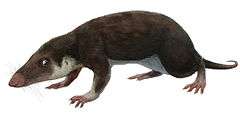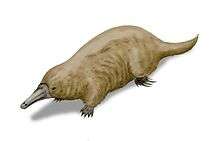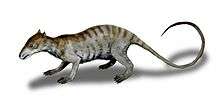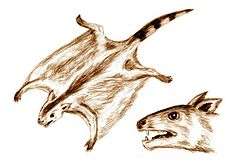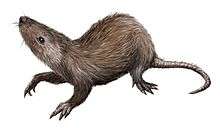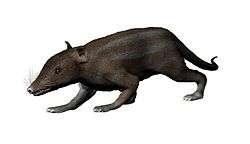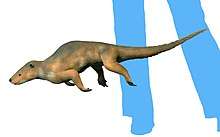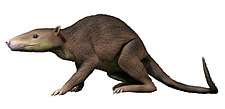Eobaataridae
Eobaataridae is a family of fossil mammal within the order Multituberculata. Remains are known from the Lower Cretaceous of Europe and Asia. These herbivores thus lived during the Mesozoic era, also known as the "age of the dinosaurs". They were among the most derived representatives of the informal suborder "Plagiaulacida".
| Eobaatarids | |
|---|---|
| Scientific classification | |
| Kingdom: | Animalia |
| Phylum: | Chordata |
| Class: | Mammalia |
| Order: | †Multituberculata |
| Suborder: | †Plagiaulacida |
| Family: | †Eobaataridae |
| Genera | |
| |
In this case of one taxon, remains are reasonably well known. This refers to Sinobaatar from the extraordinary Chinese locality of Liaoning. They were close relatives of the Plagiaulacidae, while the second upper molar has similarities to ones known from the informal Paracimexomys group within the more derived suborder, Cimolodonta.
The recently described Indobaatar from the Early Jurassic Kota Formation is the earliest known multituberculate, let alone the earliest eobaatarid, and may stretch the eobaatarid-cimolodontan group much earlier than previously thought.[5]
Genus Teutonodon is the first Jurassic mammal discovered in Germany.[4]
Fossils of Jeholbaatar kielanae seem to show a small bone from the lower jaw on its way to becoming part of the middle ear.[6]
Etymology
The name "Eobaatar" (from ancient Greek "ἠώς"= dawn and Mongolian "baatar"= hero) means "dawn hero".
Notes
- Nao Kusuhashi; Yaoming Hu; Yuanqing Wang; Takeshi Setoguchi; Hiroshige Marsuoka (2010). "New multituberculate mammals from the Lower Cretaceous (Shahai and Fuxin formations), northeastern China". Journal of Vertebrate Paleontology. 30 (5): 1501–1514. doi:10.1080/02724634.2010.501435.
- Haibing Wang; Jin Meng; Yuanqing Wang (2019). "Cretaceous fossil reveals a new pattern in mammalian middle ear evolution". Nature. 576 (7785): 102–105. doi:10.1038/s41586-019-1792-0. PMID 31776514.
- Nao Kusuhashi (2008). "Early Cretaceous multituberculate mammals from the Kuwajima Formation (Tetori Group), central Japan". Acta Palaeontologica Polonica. 53 (3): 379–390. doi:10.4202/app.2008.0302.
- Thomas Martin; Julia A. Schultz; Achim H. Schwermann; Oliver Wings (2016). "First Jurassic mammals of Germany: Multituberculate teeth from Langenberg Quarry (Lower Saxony)" (PDF). Palaeontologia Polonica 67: 171–179. doi:10.4202/pp.2016.67_171.
- Parmar, Prasad, and Kumar (2013) The first multituberculate mammal from India. Naturwissenschaften
- https://www.google.com/search?q=Jeholbaatar Google search
References
- Kielan-Jaworowska, Dashzeveg & Trofimov (1987), "Early Cretaceous multituberculates from Mongolia and a comparison with Late Jurassic forms". Acta Palaeontologica Polonica 32, p. 3-47.
- Kielan-Jaworowska, Z.; Hurum, J.H. (2001). "Phylogeny and Systematics of multituberculate mammals". Palaeontology. 44 (3): 389–429. doi:10.1111/1475-4983.00185.
External links
- Most of this information has been derived from MESOZOIC MAMMALS: Plagiaulacidae, Albionbaataridae, Eobaataridae & Arginbaataridae
